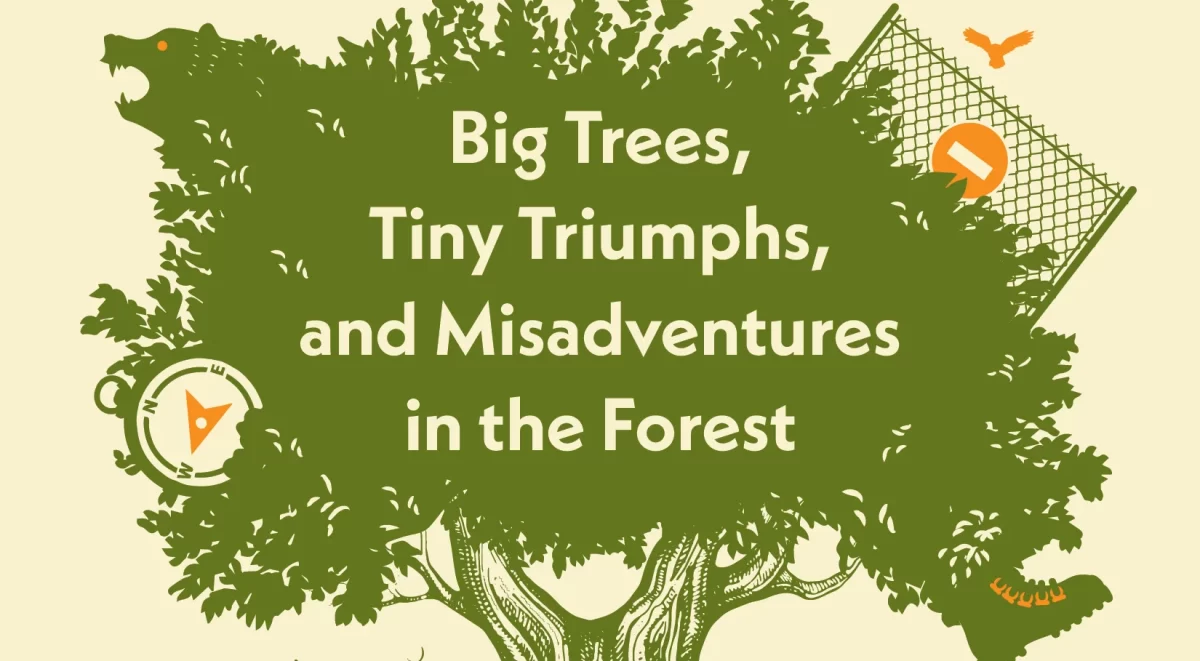
Tracking Giants: Big Trees, Tiny Triumphs, and Misadventures in the Forest
Amanda Lewis
Greystone, 2023
Review by Kim Trainor
We are surrounded by some of the most beautiful and ancient trees on the planet, yet many of us on the west coast have never even seen one in the flesh. We certainly haven’t attempted to see the largest ones documented in the BC Big Tree Registry. In the opening pages of Tracking Giants: Big Trees, Tiny Triumphs, and Misadventures in the Forest, book editor turned forest adventurer Amanda Lewis tells us, “I wanted to earn my fleece jacket and gaiters after nine years desk-bound in Toronto. I had a feeling I was playing it too safe in my life up to this point.” Upon learning of the BC Big Tree Registry, Lewis becomes obsessed with a desire to visit all 43 of the “champion trees” on the registry in a single year, using a blog to document the pursuit. We learn that the origins of the registry “grew from a desire to know what was left on the southwest coast of Vancouver Island in the wake of industrial logging throughout the twentieth century.” The subsequent book is structured as a quest for these giant trees, and for meaning in life.
For those who have not yet ventured into the forests of British Columbia, Lewis offers a vicarious adventure—the thrills of planning a trip, collecting gear, packing bear spray, and assembling maps and GPS coordinates. Along the way, the reader has an educational glimpse into the culture and lingo of forest research and logging: the water bars and requirement for high suspension on forest service roads (FSRs); how to measure a tree’s girth by diameter at breast height (DBH) using DBH tape, which comes with a sharp hook to attach the end into the bark of the tree as you wind it around the trunk; the ten essentials for survival that one must take into the backcountry. Lewis also includes thoughtful accounts of Indigenous uses of the trees she seeks to find. For example, we learn that the black hawthorn “has long thorns on its branches, which First Nations of the coast and Interior used as needles to pierce ears and lance boils, and as fishhooks. The wood is hard and useful for tool handles and implements for digging and fishing, and the Cowichan use the charcoal in face paint.” Such details offer layers of rich knowledge for the reader, from the western scientific approach to the study of trees to the millennia-old Indigenous knowledge regarding weaving trees into ways of being and living and thriving in these ancient forests.
Lewis is mindful of the history of colonization and naming conventions. The black hawthorn’s formal name is Crataegus douglasii—as Lewis observes, “another Douglas ‘discovery.’” However, a desire to be sensitive to political issues regarding divisions within Indigenous communities leads to a somewhat tepid discussion of the protests at Ada’itsx / Fairy Creek, which became the largest act of civil disobedience in Canadian history. Over 1000 protestors were arrested for placing themselves in physical blockades to stop the logging trucks from entering the watershed and its environs. For an action that has played such an important role in questioning the social contract of logging in BC, it occupies only a few pages of the book. More context on stumpage fees and agreements signed by First Nations groups in the context of TFL 46 would be helpful, and might have provided a deeper contextualization of the political, legal, and corporate forces at work that have led to the destruction of a lamentable portion of BC’s old growth forests.
The narrative arc progresses from a somewhat naïve big-eyed plan to bag every champion tree in a year’s time, to a more thoughtful understanding of a different kind of time that unfolds in the rainforest, on the scale of thousands of years. Humans are like mayflies to these west coast giants, blinking in and out of existence; by contrast, these trees live through generations of humans, through the fall of empires, and mark time by incremental, layered rings charting seasons of plenty and paucity, their trunks a living archive. Initially, she writes, “It looked like I could cross a lot of trees off my list that summer, and I plotted out their locations like a detective tracking a serial killer.” Here she speaks to her early obsession with finding the trees, a mad passion for collecting. At first, the simile, seems disturbing—why are trees compared to serial killers? This comparison speaks to an earlier mindset she has not yet grappled with: early in her journey, she has not yet learned to go into the forest simply to listen and to be. And as she continues on her quest, the author comes to realize the absurdity of her initial desire to find all 43 champions in a calendar year. As she observes,
“By looking for one tree, I began to see the forest. As I stuck with it, each outing became less about conquering and more about appreciating, and in that way my journey felt like a secular pilgrimage.”
Lewis does not shield herself in presenting her own ignorance at the start of this pilgrimage, and we learn with her. The trees, while the impetus of this book, are not its true focus. Instead, the rainforest offers the author a way to grow and learn. She develops respect for these beautiful giants as she meets many of the eccentric humans who are guided by their love of these trees. Throughout the book, she presents an honest, charming account of her own process of growth, and the steep learning curve climbed in her quest to see the forest for the trees.
Kim Trainor’s next book, A blueprint for survival will appear with Guernica Editions in Spring 2024. She is currently working on a long poem based on her experiences at Ada’itsx / Fairy Creek.